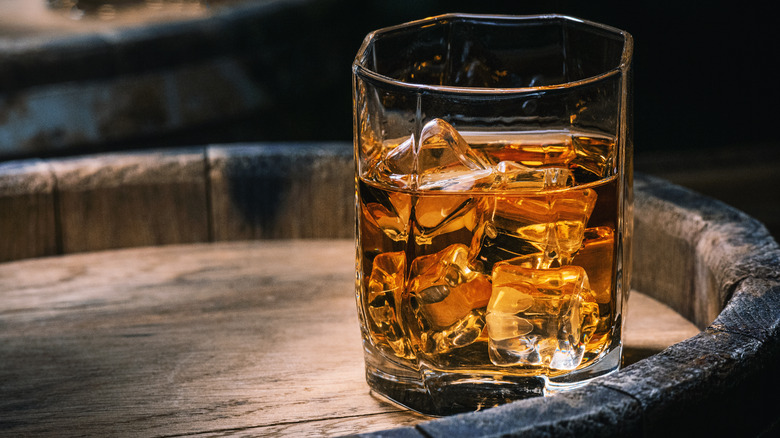What Gives Whiskey Its Color?
Vodka is clear, and whiskey is brown — this is mainstream knowledge amongst those who imbibe either. Whisky Advocate explains that dark whiskeys tend to have more shelf and social media appeal. In some instances, completely permissible caramel coloring may be used to chemically darken the spirit, according to Distiller. Distiller adds that the colors of whiskeys are often used to gauge what flavors will hit your palette — darker colors often denoting bolder tastes and senior ages. But what actually makes whiskey so dark?
Certain spirits must undergo specific, regulated production methods to be marketed under their respective names, and many details at play affect how the finished products taste and look. With whiskey-making, all of its hallmark flavor and appearance has to do specifically with a humble fixture of the process that hasn't changed much in centuries: wood. While it might seem astounding that wood is the predominant flavor of whiskey, consider how wood-smoked meats taste — and read on to find out what that means for your next scotch on the rocks.
Tasting the trees
Popular Science reports that oak trees for whiskey barrel-making are cut down in wintertime when the wood is dry, carefully processed, and seasoned outdoors in the elements. Between the individual traits of the tree and what the wood endures as it ages, the wood becomes susceptible to the chemical effects of the alcohol it will later contain, Pop Sci continues. This is all further enhanced by the "toasting process," in which the interior of the barrels are blasted with fire to create the smokiness synonymous with whiskey.
According to Whisky Advocate, the white or American oak is the go-to wood for making whiskey barrels, with bourbon demanding that the barrels be new and charred. The European or pedunculate oak is also popular. It is often used for aging Spanish sherries and barrel-finishing certain whiskeys and scotches, Whisky Advocate adds — contributing unique tasting notes to the liquor it houses. Then there's the Oregon oak, rediscovered by Westland Distillery, whose tannic intensity requires more delicate expertise yet blesses whiskey with richer, deeper flavors than other oak woods, says Whisky Advocate. Further, exotic oak species are often used to make specialty whiskeys, each with its own characteristics.
Wood and whiskey color
The same process that flavors whiskey also gives it its color. Distiller reports that white oak tends to tint whiskeys a russet color, and European oak lends more of a golden hue — and if the whiskey has been barrel-finished in a sherry or port cask, for example, it may exhibit an orange or pink blush. Yet some "white whiskey" has no color at all, having never undergone the oak barrel-aging process, Vinepair explains. Might we suggest pairing it with a bowl of white chili or perhaps a nibble of white chocolate?
But whiskey looks can be deceiving. Rather than letting your eyes decide for you, Spec's recommends dabbling in higher proof whiskeys (at least 93 proof), learning the mash bill (the grain used to make the whiskey), and trying out the less-expensive brands to get to know the spirits' true nature and your personal preferences. If you're looking to cook with whiskey, why not try fat-washed whiskey ramen or apple cheddar scones with hard cider and whiskey glaze? Whiskey might be the dark horse of the liquor cabinet, but you needn't be strangers for long.


